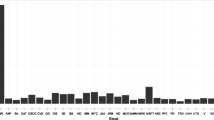Abstract
We use an experiment with a sample of professional investors to study the impact of text and emojis on investment proportion. We find that texts—provided as a supplementary information—have a statistically significant on investors’ decisions. However, the magnitude of the impact is too small (around 1%) to conclude that investor sentiment has an economically significant impact on investment decisions. We also find that emojis have no impact on investment decisions. Overall, our results are consistent with the efficient market hypothesis: in an experimental setting where the payoff and the probability of each decision are known, investment decisions of sophisticated traders are driven mostly by the type of asset, the level of risks, and the associated return of each investment and not by investor sentiment.
Access this chapter
Tax calculation will be finalised at checkout
Purchases are for personal use only
Similar content being viewed by others
Notes
- 1.
We use clustered standard errors to account for heteroskedasticity across participants.
References
Abdellaoui M, Bleichrodt H, Kammoun H (2013) Do financial professionals behave according to prospect theory? An experimental study. Theory Decis 74(3):411–429
Baker M, Wurgler J (2007) Investor sentiment in the stock market. J Econ Perspect 21(2):129–152
Bardsley N, Cubitt R, Loomes G, Moffatt P, Starmer C, Sugden R (2010) Experimental economics - rethinking the rules. Princeton University Press, Princeton
Beattie J, Loomes G (1997) The impact of incentives upon risky choice experiments. J Risk Uncertain 14(2):155–168
Camerer CF, Hogarth R (1999) The effects of financial incentives in experiments: A review and capital-labor production framework. J Risk Uncertain 19(1–3):7–42
Chen H, De P, Hu YJ, Hwang B-H (2014) Wisdom of crowds: The value of stock opinions transmitted through social media. Rev Financ Stud 27(5):1367–1403
Elliott WB, Hodge FD, Sedor LM (2012) Using online video to announce a restatement: Influences on investment decisions and the mediating role of trust. Account Rev 87(2):513–535
Elliott WB, Rennekamp KM, White BJ (2015) Does concrete language in disclosures increase willingness to invest? Rev Account Stud 20(2):839–865
Fama EF (1970) Efficient capital markets: A review of theory and empirical work. J Finance 25(2):383–417
Frèchette G (2015) Laboratory experiments: Professionals versus students. In: Frechette G, Schotter A (eds) Handbook of experimental economic methodology. Oxford University Press
Hackethal A, Kirchler M, Laudenbach C, Razen M, Weber A (2020) On the role of monetary incentives in risk preference elicitation experiments. Working Papers 2020-29, Faculty of Economics and Statistics, University of Innsbruck
Hales J, Kuang X, Venkataraman S (2011) Who believes the hype? An experimental examination of how language affects investor judgments. J Account Res 49(1):223–255
Jordà Ò, Knoll K, Kuvshinov D, Schularick M, Taylor AM (2019) The rate of return on everything, 1870.2015. Q J Econ 134(3):1225–1298
Kejriwal M, Wang Q, Li H, Wang L (2021) An empirical study of emoji usage on Twitter in linguistic and national contexts. Online Soc Netw Media 24:100149
Kralj Novak P, Smailović J, Sluban B, Mozetič I (2015) Sentiment of emojis. PloS One 10(12):e0144296
Long JBD, Shleifer A, Summers LH, Waldmann RJ (1990) Noise trader risk in financial markets. J Polit Econ 98(4):703–738
Mahmoudi N, Docherty P, Moscato P (2018) Deep neural networks understand investors better. Decis Support Syst 112:23–34
Renault T (2017) Intraday online investor sentiment and return patterns in the US stock market. J Bank Finance 84:25–40
Renault T (2020) Sentiment analysis and machine learning in finance: a comparison of methods and models on one million messages. Digital Finance 2(1):1–13
Sprenger TO, Sandner PG, Tumasjan A, Welpe IM (2014) News or noise? Using Twitter to identify and understand company-specific news flow. J Bus Finance Account 41(7-8):791–830
Tan H-t, Ying Wang E, Zhou B (2014) When the use of positive language backfires: The joint effect of tone, readability, and investor sophistication on earnings judgments. J Account Res 52(1):273–302
Tetlock PC (2007) Giving content to investor sentiment: The role of media in the stock market. J Finance 62(3):1139–1168
Tetlock PC, Saar-Tsechansky M, Macskassy S (2008) More than words: Quantifying language to measure firms’ fundamentals. J Finance 63(3):1437–1467
Trimborn S, Härdle WK (2018) CRIX an index for cryptocurrencies. J Empir Finance 49:107–122
Zetzsche DA, Buckley RP, Arner DW, Föhr L (2017) The ICO gold rush: It’s a scam, it’s a bubble, it’s a super challenge for regulators. University of Luxembourg Law Working Paper, (11):17–83
Acknowledgements
The authors gratefully acknowledge the fundings of the Sorbonne Economics Centre (https://centredeconomiesorbonne.cnrs.fr/en/home/) and of the Fédération de Recherche pour les Sciences Sociales du Comportement Humain (https://s2ch.cnrs.fr/). The authors thank the members of the audience at the Centre d’Economie de la Sorbonne, at the Laboratoire d’Economie d’Orléans of the University of Orléans and at Investor’s Emotions and Asset Pricing Meeting held the IAE Lille University School of Management and at the GDRE at the University of Strasbourg for the valuable comments.
Author information
Authors and Affiliations
Corresponding author
Editor information
Editors and Affiliations
Rights and permissions
Copyright information
© 2023 The Author(s), under exclusive license to Springer Nature Switzerland AG
About this chapter
Cite this chapter
Boulu-Reshef, B., Bruneau, C., Nicolas, M., Renault, T. (2023). An Experimental Analysis of Investor Sentiment. In: Bourghelle, D., Grandin, P., Jawadi, F., Rozin, P. (eds) Behavioral Finance and Asset Prices. Contributions to Finance and Accounting. Springer, Cham. https://doi.org/10.1007/978-3-031-24486-5_6
Download citation
DOI: https://doi.org/10.1007/978-3-031-24486-5_6
Published:
Publisher Name: Springer, Cham
Print ISBN: 978-3-031-24485-8
Online ISBN: 978-3-031-24486-5
eBook Packages: Economics and FinanceEconomics and Finance (R0)




